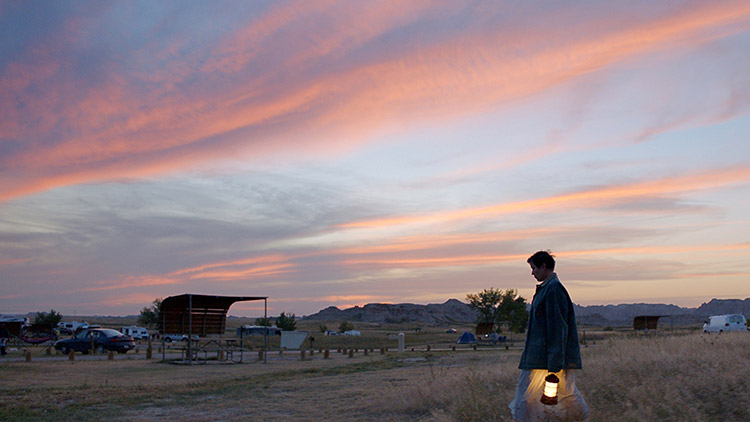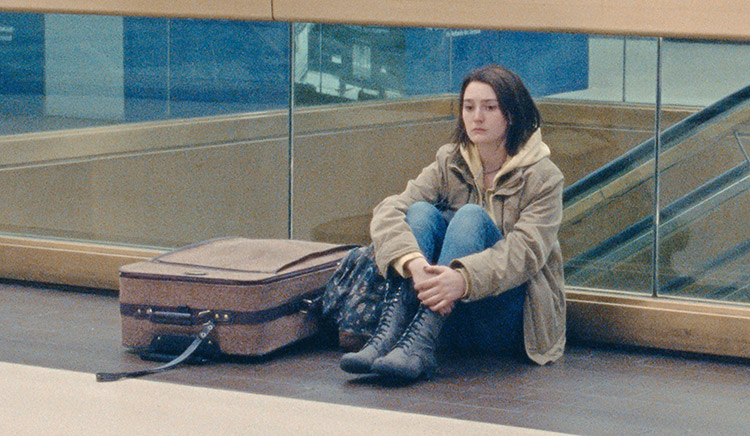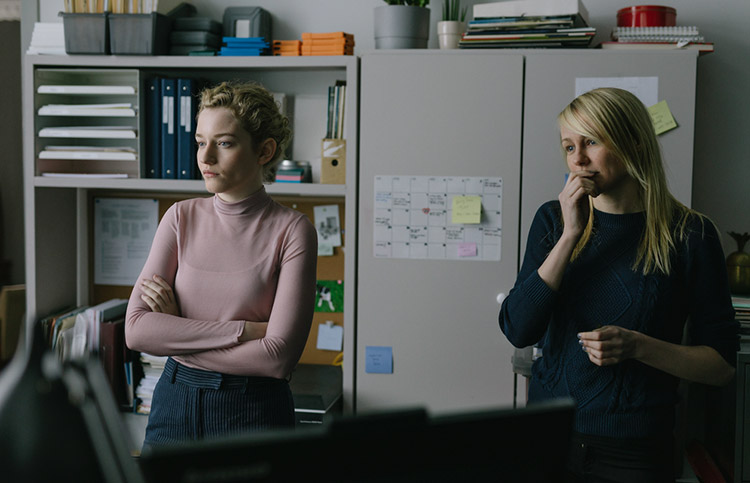ENTER YOUR EMAIL TO RECEIVE OUR WEEKLY NEWSLETTER
A Foot in the Door
Women filmmakers and female characters had starring roles in 2020
By Nancy Gendimenico

Frances McDormand in Nomadland, written, directed, and edited by Chloe Zhao.
. . . . . . . . . . . .
2020 was a stellar year for women in the independent film sector. According to a recent Indie Women study, female directors represented nearly 40 percent of those making narrative movies—that’s a historic high. And while the awards playing field is hardly level, select women are getting well-deserved industry recognition for their creative abilities.
Chloe Zhao, writer, director, and editor of Nomadland, won a Golden Globe for best director; four BAFTAs (British Academy of Film and Television Arts awards), including for best film and best director; and a Director’s Guild Award for best director of a feature film. This catapults Zhao into a frontrunner position for six Academy Award nominations, including for best picture at the 93rd awards ceremony on Sunday.
The 40-Year-Old-Version, created by first-time filmmaker Rhada Blank, won a Critic’s Choice Award. She was also nominated for a BAFTA leading actress award. Yes, she starred in this film too.
Not to overlook Never, Rarely, Sometimes, Always, written and directed by Eliza Hittman, and The Assistant, made in 2019 by Kitty Green, which have garnered numerous regional and international awards—as well as many other notable films that made it to screens in the past year.
It’s been a long climb for women filmmakers. At the outset—the silent film years of the late 19th and early 20th centuries—women dominated the industry. But their gender dominance waned with the development of talking pictures, which was when men realized that movies offered lucrative opportunities. Capitalism indeed created the studio system, and women were sidelined as consolidation occurred at the studios and powerful unions held sway in Hollywood.

Rhada Blank wrote, produced, directed, and starred in The Forty-Year-Old Version. (Jeong Park/Netflix)
. . . . . . . . . . . .
Only two women directors managed to beat the system, join the game, and emerge as forerunners of today’s crop of female filmmakers. Dorothy Arzner became the first woman member of the Directors Guild of America. She inspired the multi-talented director, producer, actress and singer Ida Lupino. Early in her career, in 1949, Lupino co-directed, co-produced, and wrote Not Wanted, a low-budget film focusing on the plight of unwed mothers. She went on to act in and develop a host of movies and TV programs well into 1970s. They included High Sierra, The Hitch-Hiker, The Sea Wolf, and episodes of The Twilight Zone.
During the 1930s-’50s, women managed to work in Hollywood as editors, talent agents, costume designers, and executive secretaries to studio heads. Female audiences were vital for a film’s success, and actresses such as Betty Davis and Joan Crawford starred in films geared to women’s interests. But despite their clout, they never ventured behind the camera.
After that period, opportunities evaporated even further, though Barbra Streisand broke though in 1983 with Yentl, becoming the first woman to write, produce, direct, and star in a studio film, for which she earned a Golden Globe for best director. And then in 1992, The Prince of Tides, which she also directed, won an Academy Award for best picture.
Streisand was an exception. According to Stacy Smith, an associate professor of communication at the University of Southern California, and the founder of the Annenberg Inclusion Initiative, a global think tank tackling inequality in Hollywood, women in the American film world became invisible, with little change over the past fifty years.
Fast forward to the 21st century. A small list of Hollywood insiders, including Angelina Jolie, Kathryn Bigelow (both known for their war films), Sophia Coppola, and Greta Gerwig have made some inroads. As has Ava DuVernay, who won a 2012 Sundance directing award; she was the first Black woman to do so. She’s now on her way with a thriving career.

Sidney Flanigan in Never, Rarely, Sometimes, Always, written and directed by Eliza Hittman.
. . . . . . . . . . . .
Filmmakers, actors, writers, and academics are speaking out with a new urgency to create gender parity. The MeToo movement laid bare the obstacles, abuse, and harassment emanating from the C-Suite on down.
Shifting U.S. demographics are another reason for pinpointing unequal opportunities. With a higher percentage of minorities in our population, more moviegoers want to see faces like theirs up on the screen. They crave diversity in gender, race, ethnicity, and age.
Economics are another factor. Pre-pandemic, women purchased 50 percent of movie tickets. A 2016 study by Slated, a company connecting filmmakers and investors, found that women generated the highest investment returns on recent films they produced, wrote, or starred in. But they continue to be grossly underrepresented in all facets of the business. Not that there is any shortage of talent. Today an equal number of men and women are completing film school.
Female talent has fueled an excellent roster of recent films. The lead character in Nomadland, Fern, played by Frances McDormand, is a sixty-plus woman grieving not only the death of her husband, but of her Nevada town, due to a company shutdown. Fern has few options after she loses her job. She purchases a van and decides to hit the road in search of work. Throughout her travels in the Arizona desert, the Badlands, and the Plains, she encounters a community of older people doing seasonal work at such places as an Amazon fulfillment center, RV campgrounds, and national parks.
Based on Jessica Bruder’s book by the same name, Nomadland deftly weaves together fictional characters with real people named Swankie and Bob Wells, the leader of the nomad movement. They teach Fern the rudiments of itinerant life. She establishes friendships and develops a relationship with Dave, played by David Strathairn. And she considers returning to a more stable situation. But she finds a certain satisfaction in her chosen lifestyle that conventional living does not offer. Older characters who populate most of the film are depicted not as caricatures, but realistically.
Zhao herself shows a sensitivity she likely developed during her time filming on location. “We discover ourselves on the road,” she’s said.
Another road film, Never, Rarely, Sometimes, Always, features 17-year-old Autumn, played by a novice actress, Sidney Flanigan. Autumn is misled about the term of her pregnancy by a healthcare practitioner in her rural Pennsylvania town, and is encouraged to keep the baby—a choice she does not want. To get a safe and legal abortion, she crosses state lines, finding a Planned Parenthood clinic in New York City where parental approval is not required. Her cousin Skyler, played by stage and film actress Talia Ryder, agrees to accompany her.
After the two arrive at Port Authority, they navigate an unfamiliar and overwhelming city to find the clinic location. There, Autumn learns that her pregnancy is advanced and an overnight stay is required for a two-part procedure. Refusing help from the staff, the girls spend part of the night on Manhattan streets and ride the subway until dawn, experiencing both the mundane and the menacing. Returning to the clinic, they walk past a crowd of anti-abortion protesters. Inside, a moving scene between Autumn and her social worker, an actual professional cast in the role, encourages truthful answers about her relationships. The final hurdle, getting the cash for a bus ticket home, spurs Skyler to devise a solution. The ordeal draws the girls closer and strengthens their friendship.

Julia Garner on the set of The Assistant with writer and director Kitty Green. Photo by Ty Johnson.
. . . . . . . . . . . .
In The Assistant, Jane, played by Julia Garner, who had a role in the TV series The Americans and the Netflix series Ozark, is a recent college graduate working as a personal assistant for an unseen male CEO at an unnamed film company. She arrives at her Manhattan office so early every morning that it is still dark outside. There, she makes the coffee, photocopies scripts, and handles travel plans. She cleans her boss’s office, picks up trash, including a lone gold earring, and does tasks of a highly personal nature for him. When Jane’s co-workers arrive at the office, they barely acknowledge her. Two young men who serve as the CEO’s assistants see fit not only to pawn off the boss’s raging wife’s phone calls to Jane, but also his unruly children, who stop by for a visit.
Another of Jane’s tasks is to welcome a young woman hired by the CEO for a position that’s not made clear. She accompanies the new employee to a fancy hotel where she will be put up. As indications of her boss’s predatory behavior continue to mount, Jane meets with a male HR representative to discuss her concerns. But instead of offering support, he belittles her for complaining and tells her not to worry. In his words: “You’re not his type.” What’s more, Jane’s complaint is swiftly communicated to the CEO, and she is expected to apologize to him in writing, with her fellow assistants coaching her on how to phrase the email.
The Assistant exemplifies the sexual harassment and abuse rife in the entertainment and media industries. It also underscores the challenges women face in getting a foot in the door in the business. Jane is told by the HR executive, “we could use more female producers,” yet his suggestion does not placate her during their tense exchange.
Getting a foot back in the door is exactly what Rhada, the main character in The 40-Year-Old Version, wants to do. In a story inspired by the director-producer-star’s own life, Rhada plays a once-promising playwright approaching age forty. Shot in black and white around Manhattan, Brooklyn, and the Bronx in just twenty-one days, her film, an homage to those freewheeling independent filmmakers John Cassavetes and Woody Allen, marks the debut of a wonderful talent. Rhada teaches theater to urban high schoolers who show her little respect. A student muses aloud, “If the teacher is so successful, why does she have to teach?” At a cocktail party, Rhada, who is Black, is told by a theater producer played by Reed Birney that her writing must be “whiter” to attract a wider audience. But her angry response nearly scuttles an opportunity to work with him. Her agent and good friend Archie, played by Peter Y. Kim, repairs the rift. The producer agrees to develop her play, but she is urged to change the story.
In her new role as a hip hop artist, Rhada seeks out D, played by Oswin Benjamin, a producer of beats and tracks for rappers’ lyrics, at his Brownsville apartment. She stays late into the night to await her turn to work with him. Rhada’s connection with D deepens as he supports her efforts. She uncovers who she wants to be at age forty.
The heroines in each of these films pursue their goals and desires despite roadblocks. Ambitions may be thwarted, but they show grace, tenacity, and wit as they travel metaphoric and physical distances to something more satisfying.
How do we ensure more excellent films like these are made and seen by a broad audience? Naomi McDougall Jones, an actor, filmmaker, and activist for gender parity, says waiting for Hollywood to grow in consciousness is not a winning strategy. Among her recommendations, from a much-watched Ted talk, “What It’s Like to Be a Woman in Hollywood,” and her book, The Wrong Kind of Women: Inside Our Revolution to Dismantle the Gods of Hollywood, are these three, which can readily be followed:
Watch movies by women and spread the word. Three websites to check out for lists of recommended films are Movies by Her, Rotten Tomatoes guide Best Movies Directed by Women of the 21st-century, and Mubi.com 100 Films Directed by Women.
Support women filmmakers in projects large and small. Many are turning to friends and family and crowdfunding to find seed money for their projects.
Do not support films in which female characters are marginalized without reason or constantly shown as victims of verbal and physical abuse while wearing scantily clad outfits. Media images that provide authentic role models for girls and women give little boys an accurate image of the female gender. This can impact their impressions and behavior in real life.
These initiatives will take time, given decades of stalled progress and entrenched male attitudes and hierarchy in the film industry. But one thing is sure. The creative work produced in the films discussed here and many others made by women in 2020 will be remembered long past their initial release. As more women sit in the director’s chair, get behind the camera, and inhabit the writing rooms to depict credible characters on screen, more viewers will seek quality films to stream or watch in movie theaters, post-pandemic. And creators will be considered accomplished without any need to add the antecedent female.
Nancy Gendimenico is a freelance writer and editor who spent over three decades in the fashion and media industries. Her essays and articles have been published in Narrative Magazine, The Villager, Art Papers, and many other periodicals. Follow Nancy on Twitter @ngendimenico.











